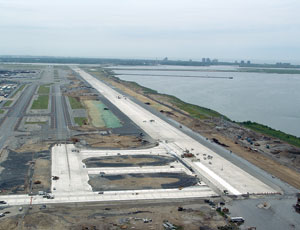Acontractor has won a $5-million bonus for repaving 10,925 ft of runway in 120 days at John F. Kennedy International Airport in New York City. The new $348-million project, which re-opened on June 29, required two online concrete batch plants, intense planning and 17,000 ft worth of fencing to render the Bay Runway—the country’s second-longest—a construction work zone.

Tutor Perini Civil Inc., Peekskill, N.Y., can win another $5-million bonus on its $210-million contract once it completes remaining work, including the 3,647 ft east section. The total job is to be completed in 2011 but could be finished this year, says Damon M. Petrillo, project manager, since crews produced so much concrete and asphalt in this phase.
The expansion—to 200 ft from 150 ft wide, with 4,900 slabs, each a 25 x 25-ft block of slipformed concrete about 18 in. thick—took four months. Planning took much longer. Two years ago, the Port Authority of New York and New Jersey used a peer-review process—conceived by William Fife, now retired from AECOM—to prepare.
“We brought in the rest of the country,” says James Steven, JFK’s redevelopment manager. “One of the first things we learned was to put the construction manager, project managers and senior engineers all in one trailer complex with the contractor. We couldn’t wait 16 hours to resolve an issue. Every second counted.”
The runway received asphalt paving 13 years ago. The authority determined that over a 40-year life cycle, concrete would save $300 million in maintenance. But asphalt is still big: Some 300,000 tons of it goes into taxiways, service roads and the new 60-ft-wide shoulders. The authority prepurchased lighting, signage and materials and consulted with the Federal Aviation Administration, the airlines and air traffic controllers. Typically, the runway handles 16 million flights a year.
Tutor Perini bought a concrete plant, and established a backup and, as a third alternative, a local supplier. Along with a Plan A, “we had Plans B, C and D,” says Petrillo. “Everybody was flexible enough to dive into the next plan.” Rich Louis, JFK deputy general manager, concurs, “We had backups to our backup plans.”
The single biggest pour on one shift was 3,400 cu yd, says Petrillo. Two slipform pavers placed on average 2,500 cu yd a day, with one day seeing 5,000 cu yd, says Thomas Amoia, the port authority’s project construction engineer. The contractor spent $4 million on the new paving plant and top-of-the-line equipment, including computerized paving guidance, adds Petrillo. “We let our subs know that we had to pour concrete every day,” he says.


Post a comment to this article
Report Abusive Comment